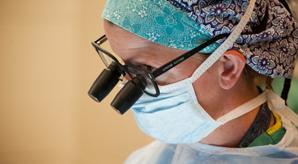Soft Tissue Surgery
Information for Veterinarians
Surgical Endoscopy
Laparoscopy and thoracoscopy are valuable tools when appropriately applied in a diagnostic plan. Minimally invasive surgery may also provide accurate and definitive diagnostic and staging information that would otherwise only be obtained only through an open surgical exploratory laparotomy or thoracotomy.
Advantages Of Surgical Endoscopy
The many advantages of minimally invasive surgery over a conventional open surgical exploratory laparotomy or thoracotomy include improved patient recovery because of smaller surgical sites, lower postoperative morbidity, infection rate, and postoperative pain.
Minimally invasive surgery is considered to be safe, having few complications and few, if any, contraindications of laparoscopy and thoracoscopy. Ascites, abnormal clotting times, and poor patient condition are only relative contraindications. Absolute contraindications for laparoscopy or thoracoscopy include septic peritonitis or conditions when obvious conventional surgical intervention is indicated. Relative contraindications include the patient condition, small body size or obesity. Patients that are either a poor anesthetic or surgical risk would obviously preclude performing the procedure.
Surgical Endoscopy Equipment
The basic equipment required for minimally invasive surgery includes:
- The telescope
- Corresponding trocar-cannula units
- Light source
- Gas insufflator
- Veress (insufflation) needle
- Various forceps and ancillary instruments
Telescopes most frequently used in small animal laparoscopy generally range in diameters from 2.7 to 10 mm. The 5 mm diameter is adequate for most small animal procedures. Different energy sources are also available to perform safe and efficient hemostatis and dissection. Stapling equipment is also available for minimally invasive surgery.
Surgical Thoracoscopy Techniques In Small Animals
Most commonly performed:
- Pericardial window
- Lung lobectomy
- Correction of persistent of right aortic arch
- Thymoma resection
- Exploration of the thoracic cavity for spontaneous pneumothorax
- Pleural biopsy
- Lung biopsy
Surgical Laparoscopic Techniques In Small Animals
Most commonly performed:
- Cryptorchid Surgery
A testicle that is located in the abdominal cavity can be removed easily with laparoscopy. This is the recommended technique to perform this type of operation because it is simple, fast and less risk of mistake during the procedure. Laparoscopic vasectomy can also be performed through this technique.
- Ovariohysterectomy/Ovariectomy
Ovariohysterectomy/Ovariectomy can be performed using laparoscopy in most all medium and large size dogs. The space in the abdominal cavity of small dogs and cats make the procedure technically very difficult.
The procedure can be performed in either lateral recumbency or dorsal recumbency. Lateral recumbency requires repositioning the patient for the second ovarian pedicle and moving the equipment to maintain the alignment for the operator viewing the monitor located at the end of the table behind the rear legs. When the dog is placed in dorsal recumbency, both ovarian pedicles can be visualized without moving either the patient or the monitor.
- Prophylactic Gastropexy
Other Laparoscopic Procedures
- Cystoscopy
- Jejunostomy or Gastrostomy Feeding Tube Placement
Gastrostomy feeding tube is placed using the laparoscopy by exteriorizing the body of the stomach through the left abdominal wall and then inserting the tube externally.
- Intestinal Feeding Tube Placement
Duodenostomy or jejunostomy feeding tubes can be placed using the laparoscope by exteriorizing a respective piece of intestine through the abdominal wall and inserting the tube externally.
- Abdominal Lavage Tube Placement
- Gastric Foreign Body Removal
Gastric foreign bodies that cannot be removed with gastroscopy should be accessed for removal with minimally invasive laparoscopic technique.
- Adrenalectomy
- Gastropexy
A preventive gastropexy can be performed using the laparoscope by exteriorizing the pyloric antrum region of the stomach through the right abdominal wall. The animal is placed in dorsal recumbency and the telescope portal is placed on the midline at the level of the umbilicus.

